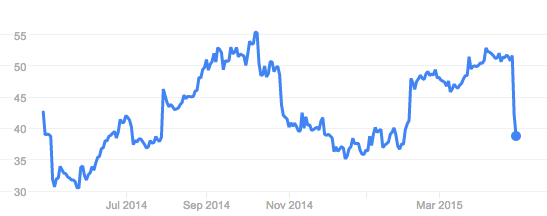The Twitter Withdrawal

A short series of tweets helped remove about eight billion dollars of value from Twitter’s stock this week. They were posted before Twitter’s official announcement by a firm that uses software to crawl the internet for financial information, and, as breaking primary materials, it’s possible they exacerbated that rate and depth of the stock’s decline. Twitter proved its purported value by wounding itself.
For years, the story of Twitter was about the people who used it: who they were, what they did, and how they did it. It was strange and fun to watch millions of people figure out what to do with this weird site; it was strange, and maybe less fun, to watch the company gradually capture and integrate its users’ ideas and habits into the service’s growing superstructure (“new” Twitter features, including hashtags, shortened links, and its entire mobile app, are often not Twitter’s ideas). It was something that a lot of people used a little, and that a few people used obsessively. Like many products, it was something people used in vastly different ways. Like fewer, it was something people figured out very much in public.
The company took its time making money. The last year before going public was a year of consolidation; it was about taming, grooming, and streamlining. Apps were pruned, ads were tested. It became a story of people versus platform, of a company trying to take back control of an intrinsically disorderly service (but not so much as to ruin it). This stage was never completed — the question of what Twitter is, or should be, was never clearly answered. More realistic questions regarding what Twitter users could expect were never addressed. People who use Twitter the most were there to stay, for a while at least, but the site was not much easier to join, or to make sense of, than it was one or two or five years before.
Twitter’s IPO changed its story in the most obvious possible way: Like any other public internet company, its narrative recentered around a single line, the direction of which is determined by the market’s blunt but pragmatic understanding of how many people use Twitter and, just as important, how much they’re worth.

This seems to have had a clarifying effect for Twitter, the product. It is less concerned with what it will become than how it can make money from what it has, so its changes — which, despite blurring together over the last year, have been significant — have been, for the first time, coherent. Maybe even predictable!
In 2013, a month before going public, Twitter starting putting images in its feeds. It added “fav” and “retweet” buttons to the main flow. The effect was Facebook-like. The feed felt more substantial, and less dependent on the things it linked to. It was no longer a scroll of jokes and comments and headlines; it was a scroll of jokes and comments and headlines and photos and videos and chunks of articles. People had a few more reasons to stay in the feed, and fewer to leave.
The path Twitter chose then is the one it still seems to be on; each change since then — most recently, Twitter added the ability to embed tweets within tweets — has emphasized Twitter’s own feed over the things it references. For years, Twitter was largely and stubbornly centered around links, contributing to the web and providing and layer through which to interpret it; now, it is withdrawing into itself.
And why not? Facebook’s line about how linking to outside articles is a bad experience — in that it takes a few seconds — is absolutely true if you privilege the Facebook experience, which Facebook obviously does. Its users reflect this back at Facebook when a video embedded in the Facebook feed, rather than hidden behind a play button or a website, is noticed and watched more.
Twitter is seeing a similar sort of confirmation. It is possible to embed enough media inside Twitter — images, videos, GIFs, article previews — that its users now expect to be able to embed anything. My (admittedly news-centric) Twitter feed is full of people trying to cram more into each tweet. Instead of linking to news stories, people will link to tweets about news stories, which contain enough information to serve that purpose; instead of quoting a few words from an article in a tweet, people will screenshot and highlight multiple paragraphs. There are quotes everywhere, in part because there are tools designed to make posting them easier. The best one was created, perhaps not entirely coincidentally, by a former VP at the Twitter.
The resulting feed is one in which links are variously demoted. Links are hat-tips, polite credits, or customary reminders that there is more to see, somewhere else, if you care. They contain the leftovers — the things that weren’t good enough for the screenshot, the highlight, and the post. Eventually, they’re metadata.
Remember before Twitter, @vilkomerson, when people would say ANYTHING to a reporter? http://t.co/ZPec6e6rCI pic.twitter.com/5WNxQnCPr3
— Choire (@Choire) April 30, 2015
Now imagine, in some near-future version of Twitter, a tweet that expands not just into a card but into a fuller preview, or even an entire article. Perhaps Twitter could formalize some rules for outside text content! Perhaps web publishers would balk at such a system, which would represent one more concession to an internet that is increasingly hostile to their existence, but they wouldn’t have much choice. Without Twitter’s help, some of its most active users are hashing out this new form of aggregation — part blogging, part self-promoting, part performance, and entirely on Twitter.
Internet platforms inherently favor their own content; more subtly, they create the conditions for their users to do the same. Maybe Twitter finishes withdrawing from the web, withers, and dies. Or maybe it gradually envelops its users and finds a way to extract more money from them! Maybe it will find itself somewhere in the middle, able to monetize millions of users who are increasingly aware that their conversations are now occurring on someone else’s terms, and are becoming resentful of this fact.
Or maybe, after the big social networks have declared independence from the web that birthed them, it will turn out that feeds don’t make very good channels at all.
